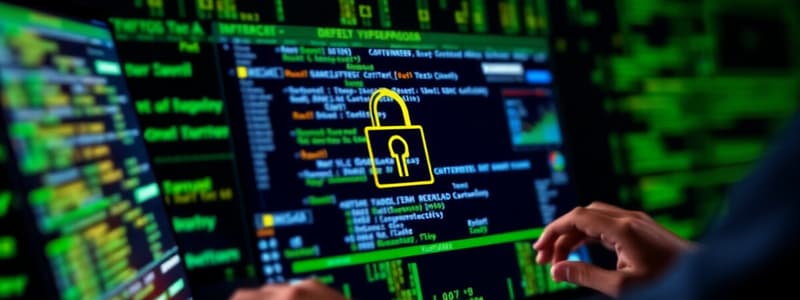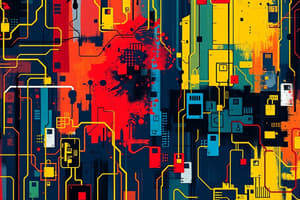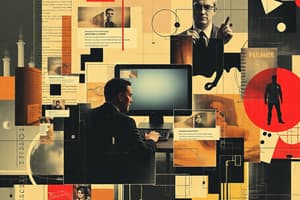Podcast
Questions and Answers
Which of the following is considered a digital security risk?
Which of the following is considered a digital security risk?
- Privacy violations
- System crashes
- Loss of data
- All of the above (correct)
What is the primary purpose of digital forensics?
What is the primary purpose of digital forensics?
- To create automated software for attacks
- To discover, collect, and analyze evidence from digital devices (correct)
- To protect user data from theft
- To enhance the speed of computer systems
What is the term used for individuals who lack advanced knowledge but still engage in cyberattacks?
What is the term used for individuals who lack advanced knowledge but still engage in cyberattacks?
- Hackers
- Attackers
- Threat actors
- Script kiddies (correct)
Which of the following is NOT a benefit of participating in a digital detox?
Which of the following is NOT a benefit of participating in a digital detox?
What is the primary characteristic of the Dark web?
What is the primary characteristic of the Dark web?
In the context of cybercrime, what is typically called 'crimeware'?
In the context of cybercrime, what is typically called 'crimeware'?
What skills are essential for a digital forensics examiner?
What skills are essential for a digital forensics examiner?
What term broadly encompasses individuals who launch attacks on computer systems?
What term broadly encompasses individuals who launch attacks on computer systems?
What is the primary function of OCR software?
What is the primary function of OCR software?
How does a MICR reader function?
How does a MICR reader function?
Which device is designed specifically to read magnetic stripes on cards?
Which device is designed specifically to read magnetic stripes on cards?
What is a disadvantage of basic thermal printers?
What is a disadvantage of basic thermal printers?
What unique capability does a Smart TV have?
What unique capability does a Smart TV have?
What is the main purpose of a data projector?
What is the main purpose of a data projector?
What defines cloud storage?
What defines cloud storage?
What device is commonly used to enhance the visibility of an instructor's presentation?
What device is commonly used to enhance the visibility of an instructor's presentation?
What is the main difference between a hacker and a cracker?
What is the main difference between a hacker and a cracker?
Which term describes the act of manipulating a website to make a political statement?
Which term describes the act of manipulating a website to make a political statement?
What is the primary goal of cyberwarfare?
What is the primary goal of cyberwarfare?
What does social engineering typically attempt to do?
What does social engineering typically attempt to do?
Which of the following is NOT considered a form of internet or network attack?
Which of the following is NOT considered a form of internet or network attack?
What is the primary aim of a cyberextortionist?
What is the primary aim of a cyberextortionist?
Which technology-related ethical guideline focuses on reducing electricity consumption?
Which technology-related ethical guideline focuses on reducing electricity consumption?
What function does spyware typically perform?
What function does spyware typically perform?
What is a primary function of a worm in computing?
What is a primary function of a worm in computing?
What purpose does a back door serve in a program?
What purpose does a back door serve in a program?
Which of the following best defines a Denial of Service attack?
Which of the following best defines a Denial of Service attack?
What distinguishes a virtual private network (VPN) from regular networks?
What distinguishes a virtual private network (VPN) from regular networks?
How do firewalls protect network resources?
How do firewalls protect network resources?
What type of input does voice input technology use?
What type of input does voice input technology use?
What advantage does ergonomic keyboard design offer?
What advantage does ergonomic keyboard design offer?
What technology does an optical scanner primarily utilize?
What technology does an optical scanner primarily utilize?
What does SDHC stand for in Micro SDHC cards?
What does SDHC stand for in Micro SDHC cards?
What is the primary function of a signature capture pad?
What is the primary function of a signature capture pad?
Which of the following best describes a foot mouse?
Which of the following best describes a foot mouse?
What is the main purpose of formatting a disk?
What is the main purpose of formatting a disk?
Which of the following describes a DVD?
Which of the following describes a DVD?
What is a File Manager used for?
What is a File Manager used for?
Which statement differentiates a Real-Time Operating System (RTOS) from general-purpose operating systems?
Which statement differentiates a Real-Time Operating System (RTOS) from general-purpose operating systems?
What is the role of a Device Manager in a computer system?
What is the role of a Device Manager in a computer system?
What is access time in computing?
What is access time in computing?
Which of the following is NOT an advantage of SSDs over traditional hard disks?
Which of the following is NOT an advantage of SSDs over traditional hard disks?
What does RAID stand for in a computing context?
What does RAID stand for in a computing context?
What is a feature of RAM?
What is a feature of RAM?
How does a network attached storage (NAS) function?
How does a network attached storage (NAS) function?
What is a characteristic of a head crash in hard disk drives?
What is a characteristic of a head crash in hard disk drives?
How does a wireless microphone transmit sound?
How does a wireless microphone transmit sound?
What is the primary function of a RAID array?
What is the primary function of a RAID array?
Flashcards
Digital Security Risk
Digital Security Risk
Any event or action that could cause harm to computer or mobile device hardware, software, data, or processing capability.
Cybercrime
Cybercrime
Intentional breach of digital security, often illegal acts using computers or related devices.
Digital Forensics
Digital Forensics
Discovery, collection, and analysis of evidence from computers and networks.
Digital Forensics Examiner
Digital Forensics Examiner
Signup and view all the flashcards
Digital Detox
Digital Detox
Signup and view all the flashcards
Threat Actor
Threat Actor
Signup and view all the flashcards
Dark Web
Dark Web
Signup and view all the flashcards
Script Kiddie
Script Kiddie
Signup and view all the flashcards
Hacker
Hacker
Signup and view all the flashcards
Cracker
Cracker
Signup and view all the flashcards
Hactivist
Hactivist
Signup and view all the flashcards
Cyberterrorist
Cyberterrorist
Signup and view all the flashcards
Cyberwarfare
Cyberwarfare
Signup and view all the flashcards
Data mining
Data mining
Signup and view all the flashcards
Cyberextortionist
Cyberextortionist
Signup and view all the flashcards
Social engineering
Social engineering
Signup and view all the flashcards
Worm
Worm
Signup and view all the flashcards
Back Door
Back Door
Signup and view all the flashcards
Denial of Service Attack
Denial of Service Attack
Signup and view all the flashcards
VPN (Virtual Private Network)
VPN (Virtual Private Network)
Signup and view all the flashcards
Firewall
Firewall
Signup and view all the flashcards
Biometric Security
Biometric Security
Signup and view all the flashcards
Toggle Key
Toggle Key
Signup and view all the flashcards
Optical Scanner
Optical Scanner
Signup and view all the flashcards
QR code
QR code
Signup and view all the flashcards
MICR Reader
MICR Reader
Signup and view all the flashcards
Magstripe reader
Magstripe reader
Signup and view all the flashcards
Ink-Jet Printer
Ink-Jet Printer
Signup and view all the flashcards
Thermal Printer
Thermal Printer
Signup and view all the flashcards
Smart TV
Smart TV
Signup and view all the flashcards
Data projector
Data projector
Signup and view all the flashcards
Cloud storage
Cloud storage
Signup and view all the flashcards
Access time
Access time
Signup and view all the flashcards
Zettabyte (ZB)
Zettabyte (ZB)
Signup and view all the flashcards
SSD (Solid State Drive)
SSD (Solid State Drive)
Signup and view all the flashcards
RAID (Redundant Array of Independent Disks)
RAID (Redundant Array of Independent Disks)
Signup and view all the flashcards
RAM
RAM
Signup and view all the flashcards
Head Crash
Head Crash
Signup and view all the flashcards
Network Attached Storage (NAS)
Network Attached Storage (NAS)
Signup and view all the flashcards
Force Feedback
Force Feedback
Signup and view all the flashcards
Micro SDHC Card
Micro SDHC Card
Signup and view all the flashcards
Signature Capture Pad
Signature Capture Pad
Signup and view all the flashcards
Foot Mouse
Foot Mouse
Signup and view all the flashcards
Formatting a Disk
Formatting a Disk
Signup and view all the flashcards
DVD
DVD
Signup and view all the flashcards
LINUX
LINUX
Signup and view all the flashcards
File Manager
File Manager
Signup and view all the flashcards
Real-Time Operating System (RTOS)
Real-Time Operating System (RTOS)
Signup and view all the flashcards
Study Notes
Digital Security, Ethics, and Privacy: Avoiding and Recognizing Threats
- A digital security risk is any event or action that could cause a loss of or damage to computer or mobile device hardware, software, data, information, or processing capability.
- Types of digital security risks include threats to: information, physical health, mental health, and the environment.
- Cybercrime: An intentional breach of digital security, often involving a deliberate illegal act using a computer or related devices. Software used in cybercrimes is sometimes called crimeware.
- Digital Forensics (Cyber-forensics): The discovery, collection, and analysis of evidence found on computers and networks. This involves examining media, programs, data, and log files on computers, mobile devices, servers, and networks.
- A digital forensics examiner needs law knowledge, technical experience, good communication skills, understanding of corporate structures and policies, a willingness to learn and update skills, and problem-solving abilities.
- Digital Detox: A period of time during which an individual refrains from using technology to improve behavioral health and well-being, resulting in better sleep, reduced anxiety, and more productive thoughts and actions.
- Cybercrimes and Criminals (Threat Actors): The technical term for these 'thieves' is a threat actor; a more general and common term used to describe individuals who launch attacks against other users and their computers. Simply called attackers.
- The Dark Web: A part of the web accessed using specialized software where users and website operators can remain anonymous.
- Script Kiddies: Individuals who want to attack computers but lack the knowledge of computers and networks. They download freely available tools to carry out attacks.
Risks Associated with Technology Use
- Cybercrime: Intentional breaches of digital security often involve deliberate illegal acts.
- Any illegal act using a computer or related devices is generally considered a computer crime.
- Software used by cybercriminals is sometimes called crimeware.
- Digital forensics involves the discovery, collection, and analysis of evidence found on computers and networks. This includes the examination of media, programs, data, and log files on computers, mobile devices and networks.
Internet and Network Attacks
- Malware: Software designed to harm or disrupt a computer system.
- Botnets: Networks of compromised computers controlled remotely by attackers.
- Denial-of-service (DoS) attacks: Attacks that overload a server or network with traffic, denying legitimate users access.
- Backdoors: Programs or instructions that allow users to bypass security controls.
- Spoofing: The act of disguising a message or connection to appear as though it originated from a trusted source.
Cybersecurity Concepts
- Firewalls: Used to protect network resources from outsiders.
- Biometric security: Uses unique characteristics (face, hands, eyes) to authenticate users.
- Content filtering: Restricting access to certain material.
- Toggle keys: Keys that alternate views or features. (Caps lock, Num lock)
- Ergonomic keyboards: Designed to reduce repetitive strain injuries.
- Trackballs: Stationary pointing devices used in computers.
- Digital cameras (touch input): Using touch gestures to browse photos.
- Stylus: Small metal or plastic device used for input.
Input Devices
- Voice Input: Entering input by speaking to a microphone.
- Motion-sensing devices: Wireless technology devices translating gestures into input.
- Optical scanners: Optical input devices that read printed text.
- OCR (Optical Character Recognition): Converting scanned text to digital text.
- QR codes (Quick Response codes): 2-D bar codes storing information.
Output Devices
- MICR Readers: Devices that read text printed with magnetized ink.
- Magstripe readers: Read the magnetic stripe on credit and other similar cards.
- Ink-jet printers: Spraying tiny ink drops to form characters.
- Thermal printers: Using heated pins to generate images on heat-sensitive paper.
Computer Storage
- SSD (Solid State Drives): Flash memory storage devices.
- RAID (Redundant Array of Independent Disks): A group of hard drives that duplicates data for reliability.
- RAM (Random Access Memory): Volatile memory that stores data while the computer is on.
- Head crashes: Occur when a read/write head touches the surface of a platter affecting data.
- Cloud storage: Keeping information on servers on the Internet and the actual media transparent to the user.
- Access time: Time it takes for a computer to retrieve data.
- Zettabyte: A unit of data measurement (1 sextillion bytes).
- Network Attached Storage (NAS): A server placed on a network for storage purposes.
Other Topics
- Data Mining: The process of extracting usable data from large amounts of raw data.
- Cyber-extortionist: Individuals who launch attacks against a nation's compute networks to cause disruption, panic, and/or demands.
- Social Engineering: Tricking victims into giving valuable information.
- Hactivist attacks: Intentional attacks to make a political statement.
- Cyberterrorism: Attacking a nation's computer networks with the goal of disrupting and causing panic among civilians.
- Cyberwarfare: An attack to disable a country's computer network or cripple it's functions.
- Ethics and Society: Moral guidelines for computer use.
More technical topics
- Secure Digital High Capacity (SDHC) cards: Small cards used to expand device memory.
- Signature capture pads: Electronically record signatures.
- Foot mice: Computer input devices controlled by feet.
Studying That Suits You
Use AI to generate personalized quizzes and flashcards to suit your learning preferences.




